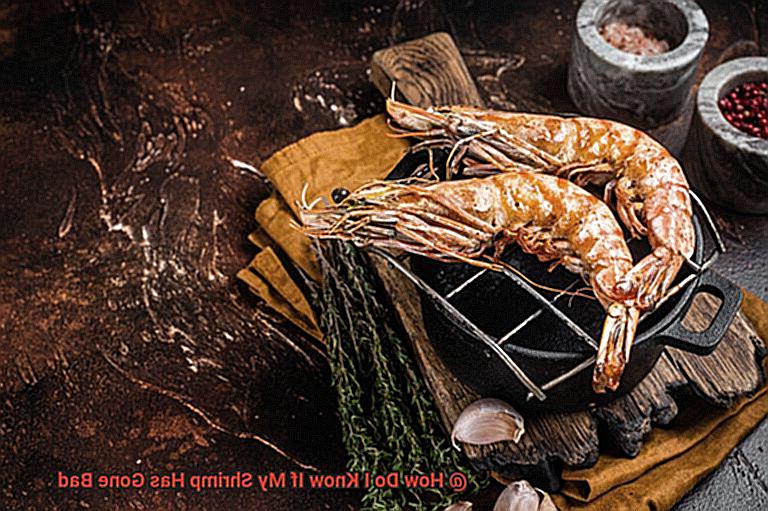Imagine this: you’ve been eagerly anticipating that mouthwatering shrimp dish you’ve planned all week. Finally, the time comes to whip it up, only to be hit with a putrid and repulsive smell. Your excitement quickly deflates, leaving you wondering, “How can I tell if my shrimp has gone bad?”
Whether you’re a seafood aficionado or a culinary novice, it’s crucial to know the signs that scream shrimp spoilage. Consuming rotten shrimp can lead to foodborne illnesses and turn your gourmet experience into a disaster. But fear not, because we’re here to save the day.
In this blog post, we’ll delve deep into this topic, unraveling the enigma of shrimp spoilage and transforming you into an expert at assessing the freshness of this tantalizing delicacy. So buckle up and prepare yourself for an exploration of unmistakable indicators that will rescue your taste buds from catastrophe.
Main Points:
Trust Your Nose: When it comes to shrimp, your olfactory senses are your most trustworthy allies. We’ll uncover the distinct odors that signify spoilage and teach you how to differentiate between the briny aroma of freshness and the stench of rotten seafood.
Slimy or Suspicious? Shrimp enthusiasts dread encountering slimy textures in their seafood, but is it always cause for concern? We’ll unveil the truth behind slimy shrimp and equip you with the knowledge to distinguish between fresh and foul.
- Peering into Truthful Eyes: Just as eyes are windows to the soul, a shrimp’s eyes can reveal its freshness. We’ll demonstrate how examining those shiny black orbs can determine whether your catch is top-notch or past its prime.
- Consistency Counts: Touch is a powerful tool for identifying spoiled seafood. We’ll guide you in evaluating the texture of shrimp, clarifying the difference between firm, springy flesh and mushy, sticky meat.
- The Icing on the Cake: Proper storage is a critical factor in preserving shrimp quality. We’ll provide invaluable insights on how temperature, timing, and handling can significantly impact the shelf life of this delightful crustacean.
With our comprehensive guide at your disposal, you’ll no longer need to play a guessing game when it comes to the freshness of your shrimp. By relying on your senses and being attuned to visual and tactile cues, you can confidently prepare delect
Contents
Examining the Smell of Shrimp
In the realm of seafood, the scent is a paramount indicator of both flavor and safety. Amongst them all, the smell of shrimp stands as a reliable informant of its edibility. Let us embark on a sensory journey, exploring the nuances of shrimp aroma, discerning between freshness and spoilage. By delving into the olfactory experience, we can confidently determine whether our precious shrimp is fit for consumption or destined for disposal.
The Freshness Test: A Whiff of Ocean Breezes

Fresh shrimp carries a mild, slightly sweet, and clean fragrance, reminiscent of the ocean’s embrace. Allow your senses to be whisked away to sandy shores as you take in the aroma. If it evokes pleasant memories and transports you to the sea, your shrimp is most likely fresh.
Fishy or Ammonia-like Odor: A Stench of Spoilage
Beware the pungent stench of fishiness or ammonia that wafts from decaying shrimp. These foul odors are telltale signs of spoilage, caused by bacterial breakdown. When trimethylamine oxide (TMAO) decomposes into dimethylamine (DMA) and trimethylamine (TMA), these compounds create the dreaded fishy smell. Similarly, an ammonia-like scent signifies harmful bacterial decomposition, producing putrescine and cadaverine.
Briny or Iodine-like Aroma: A Tangy Tinge
While fresh shrimp may possess a subtle briny or iodine-like aroma, any overpowering or unpleasant smells signal spoilage. Trust your nose to detect any off-putting odors that might elude you from a distance. Your olfactory prowess will reveal hidden secrets that determine freshness.
Appearance: The Glimmer of Freshness
Observe the translucent allure of fresh shrimp, their surfaces glistening with vitality. These visual cues manifest their freshness and quality. However, be cautious if the shrimp appears slimy, clouded, or loses its luster. These signs may indicate a journey beyond freshness.
Assessing the Appearance of Shrimp
In our previous section, we delved into the tantalizing scents that reveal the freshness of shrimp. But now, let’s embark on a visual journey that will unravel the hidden truths about these exquisite crustaceans. Grab your magnifying glass and join us as we explore the enchanting world of shrimp assessment.
Color: A Kaleidoscope of Hues
Let’s start our voyage by immersing ourselves in the captivating colors of shrimp. Fresh shrimp should possess a vibrant and translucent allure, as if they were plucked from the depths of the ocean. Depending on their species, these delicate creatures can display a range of colors, from ethereal grayish-white to mesmerizing pinkish-orange. However, beware of any discoloration that tarnishes their beauty—a dull or yellowish hue may signal the dreaded spoilage.
Texture: From Firm and Springy to Mushy and Slimy
Now, let’s get up close and personal with our shrimpy companions. Give them a gentle squeeze, and pay heed to their texture. Fresh shrimp should reward your touch with a firm and slightly springy resistance. Imagine the sensation of pressing on a perfectly ripe grape—that’s precisely what you should seek. However, if their touch turns mushy or slimy under your fingertips, it is an unmistakable sign that they have lost their luster. We want our shrimp to possess a bounce in their step.
Shell: The Guardian Shield
As we journey deeper into our visual exploration, let’s examine the protective armor of our beloved shrimps—their shells. A shell that remains intact and firmly attached to its body is a testament to freshness. Any cracks, breakage, or looseness in this armor raise suspicions of potential spoilage lurking within. And don’t forget to scrutinize the shell for the presence of dark spots or patches, as these unwelcome blemishes may indicate the growth of nefarious bacteria. It’s time to bid farewell to those compromised crustaceans.
Judging the Texture of Shrimp
In our previous expedition, we uncovered the visual secrets of shrimp freshness. Today, we plunge even deeper into the depths of this delectable crustacean’s texture. Join us on this thrilling adventure as we become masters at assessing the texture of shrimp by deciphering its firmness, color, smell, and shell. Prepare your magnifying glasses, for we are about to embark on an exhilarating journey together.
The Firmness Factor:
In the realm of judging shrimp texture, firmness reigns supreme. Imagine a ripe grape that offers the perfect balance of suppleness and resilience. That’s precisely how fresh shrimp should feel when gently prodded. Its flesh should bounce back with a delightful springiness under your touch. If it disappoints with a mushy or slimy sensation, my friend, it’s time to bid farewell to those expired crustaceans.
The Colors of Freshness:
Like a mesmerizing kaleidoscope, the colors of shrimp disclose their freshness secrets. Seek out a translucent appearance tinged with a delicate pink or grayish hue. This indicates that your shrimp is still at its peak. However, should you encounter opaque meat or a yellowish tint, alas. It’s time to part ways with those spoiled creatures.
The Nose Knows:
Ah, the alluring sense of smell – a trusted ally in our quest for fresh shrimp. Inhale deeply the aroma of your seafood treasure. A mild fragrance with a hint of saltiness reminiscent of the sea is what you seek. But beware. Should your olfactory senses detect an ammonia-like odor or any unpleasant scent that makes your nose crinkle in distaste, it is best to sever ties with that shrimp immediately.
Shell Assessment:
The shell, a stalwart guardian against spoilage, can reveal much about a shrimp’s freshness. Observe closely. A lustrous and intact shell generally signifies that your shrimp is still at the pinnacle of perfection. However, beware discolored, cracked shells that emit an off-putting aroma. These are signs it’s time to cast your net in a different direction.
Inspecting the Shells of Shrimp
Welcome back, fellow shrimp enthusiasts. Join me once again as we embark on a thrilling expedition to explore the captivating world of “Inspecting the Shells of Shrimp.” In this enthralling quest, we will delve deep into the secrets hidden within those delicate shells, uncovering vital signs that will guide us towards the freshest and most delectable shrimp.
Let us begin our exploration with the first captivating sub-topic:
Discoloration: Picture a shimmering pearl, its opalescent beauty captivating all who behold it. Similarly, fresh shrimp should mesmerize us with their translucent appearance, adorned with a soft blush of pink or grayish hues. Dull or grayish shells, on the other hand, reveal a darker truth – a potential spoilage lurking within. Remember, vibrant shells hold the promise of freshness.
Moving swiftly along our journey, we encounter our next captivating sub-topic:
Texture: Imagine running your hands through satin sheets, feeling their smoothness and gentle resistance. Fresh shrimp shells should offer a similar experience – firm yet yielding, slightly slippery to the touch. But beware. Should you encounter shells that feel excessively slimy or sticky, it serves as a warning sign. Bacterial growth or decomposition may have taken hold, tainting the integrity of our precious crustaceans. We seek shells that are firm and slick, like a well-oiled machine.
Our expedition takes an intriguing turn as we approach our next sub-topic:
Mold Alert: Cast your gaze upon the shells before you, dear explorers. Do you detect any blemishes marring their pristine surface? Beware the insidious presence of mold – dark spots or patches that betray the irreversible decay of our beloved shrimp. Mold growth marks the end of their journey as viable food sources. Let us discard these tainted creatures and seek perfection in our shells, free from the clutches of mold.
As we venture further, we encounter a familiar ally – our sense of smell. Brace yourselves for the olfactory adventure that awaits us in our next sub-topic:
Testing the Taste of Shrimp
Today, we embark on a flavorful journey as we uncover the art of testing the taste of these succulent crustaceans. Prepare your taste buds and olfactory senses, for they hold the key to unlocking the secrets of shrimp freshness.
As we dive into the depths of shrimp tasting, let us first rely on our trusty guides – our senses of taste and smell. Just like skilled detectives, they will reveal whether our precious shrimp are fit for consumption or should be cast aside. So, don your detective hats and let us unravel the mysteries that lie within.
The taste of fresh shrimp is a symphony of mildness, sweetness, and a subtle touch of saltiness that dances delicately on the palate. Close your eyes and savor the moment as these flavors delight your senses. But beware. Should you encounter an overpowering fishiness or catch a whiff of pungent ammonia, it is a clear signal that your shrimp has met its demise and should be avoided like treacherous currents.
Texture is another crucial element in deciphering the taste of shrimp. When you press your fingers against a fresh specimen, it should offer resistance, firmness, and a slight springiness. These tactile sensations are the hallmarks of quality seafood. However, if the texture veers towards mushiness or sliminess, it is time to bid farewell to that particular maritime delight.
Now, here’s a word of caution: cooking can sometimes deceive our senses, masking the unpleasant taste and smell of spoiled shrimp. To prevent disappointment from invading your plate, always rely on your senses before subjecting those shrimps to heat. Trust me when I say that prevention is far better than enduring a ruined dish.
While indulging in the flavorsome pleasure that is shrimp, remain vigilant for any unexpected tastes or aftertastes that may disrupt the harmony of your meal. Spoiled shrimp can leave behind a bitter or metallic note, swiftly turning your culinary adventure into a regrettable misstep. Therefore, take your time, savor each bite, and investigate any suspicious flavor profiles that may arise.
If you find yourself in doubt about the taste of your shrimp, embark on a delectable experiment. Compare it to a fresh and properly stored batch. By undertaking this scrumptious endeavor, you can easily discern any discernible differences in flavor and make an informed judgment on the quality of your seafood treasure.
Trusting Your Senses
Today, we’re delving deep into the world of shrimp freshness and uncovering the secrets to trusting your senses when it comes to determining if those delectable crustaceans have gone bad. From the tantalizing aroma to captivating appearance, exquisite texture, and mouthwatering taste, we’ll equip you with the tools to confidently assess the quality of your shrimp. So, let’s not waste any time and dive right in.
Sense of Smell:
Imagine this: as you bring a batch of shrimp closer to your nose, you inhale deeply, anticipating the delightful scent of the sea. A fresh shrimp should exude a gentle, sweet fragrance with a hint of brininess. However, if a pungent fishy or ammonia-like odor assaults your olfactory senses, it’s an unmistakable sign that your shrimp has seen better days. These unpleasant smells are clear indicators of bacterial growth or decomposition.
Sense of Appearance:
They say beauty is in the eye of the beholder, but when it comes to shrimp, there are specific visual cues you should be on the lookout for. Fresh shrimp should possess a translucent allure with a lustrous and firm texture. The color may vary depending on the species, ranging from elegant shades of gray to vibrant hues of pink or even mesmerizing tones of blue. However, if you spot any unsightly black spots or patches on the surface, it’s an undeniable signal of spoilage. Additionally, if the flesh appears slimy or mushy, it’s best to bid farewell to those shrimp.
Sense of Texture:
Now it’s time to get hands-on with our assessment. When you gently touch fresh shrimp, it should offer resistance and bounce back with a springy texture. A slight firmness is a commendable trait. However, if you encounter softness or squishiness, it’s a glaring red flag indicating the disintegration of the shrimp’s structure. Furthermore, pay close attention to the shell – if it easily detaches from the flesh or if you stumble upon shells that have already parted ways, it’s a surefire sign that your shrimp is past its prime.
Signs to Look Out For
In our previous section, we embarked on a sensory journey, exploring the tantalizing world of shrimp freshness. From the alluring appearance to the mouthwatering taste, we learned to trust our senses like seasoned detectives. But what if you’re faced with a shrimp that may have gone bad? Fear not, because today we’ll be diving into the signs to look out for when determining if your shrimp is still fresh. Let’s get started.
- Appearance: First impressions matter, even when it comes to shrimp. Fresh shrimp should have a translucent and shiny appearance, like a tiny jewel from the sea. But beware. Any discoloration, such as a gray or yellowish tint, is a clear sign that your shrimp might be past its prime. And if the shrimp looks slimy or has a mushy texture, it’s best to bid it farewell.
- Smell: Ah, the sense of smell, a powerful tool in our quest for freshness. Fresh shrimp should have a mild and slightly salty scent, reminiscent of the ocean breeze. But beware. A strong ammonia or fishy odor coming from your shrimp is a red flag. Trust your nose; if the smell is off-putting, it’s better to be safe and avoid consuming it.
- Texture: When it comes to texture, fresh shrimp should be firm and slightly springy to the touch. Imagine giving it a gentle squeeze and feeling that satisfying bounce back. But if your shrimp feels soft or mushy instead, it may have taken a turn for the worse. And here’s another telltale sign: if your shrimp easily falls apart or breaks when handled, it’s time to say goodbye.
- Shell condition: The condition of the shell can reveal a lot about your shrimp’s freshness. A healthy shrimp will have an intact and tightly attached shell, like a protective armor. But if you notice that the shell is loose or detached from the meat, it’s a warning sign. This could indicate that the shrimp has been sitting for too long and has started to deteriorate.
How to Avoid Spoilage
Indulging in succulent shrimp is a delight, but the key to savoring its freshness lies in proper handling, storage, and cooking techniques. In this comprehensive guide, we’ll unlock the secrets to ensure your shrimp remains delectably fresh and safe to consume. From selecting the best shrimp to mastering storage and cooking techniques, you’ll become a shrimp connoisseur in no time.
Selecting Pristine Shrimp:
To ward off spoilage from the start, it’s paramount to acquire pristine shrimp from a trustworthy source. Seek out shrimp that boasts a firm texture, exudes a gentle oceanic aroma, and flaunts a clean appearance. Steer clear of slimy, discolored, or nauseatingly ammonia-scented shrimp as these are telltale signs of spoilage.
Masterful Handling:
Once you bring home your treasure trove of fresh shrimp, handle it with utmost care. Keep the shrimp in a state of blissful chilliness by storing it either in the refrigerator or atop a bed of ice. If you find yourself transporting these gems from store to home, safeguard their freshness by snugly nestling them within an insulated bag or cooler brimming with ice packs.
Storage Artistry:
The art of proper storage holds the key to preventing shrimp from meeting an untimely demise. Safeguard their freshness by cocooning them within airtight containers or tightly wrapped in plastic before nestling them in the refrigerator’s icy sanctuary. Remember, isolation is essential. Keep your shrimp away from robust-smelling foods that may corrupt their delicate essence.
Freezing Elegance:
For those moments when immediate consumption seems elusive, freezing becomes your ally in preserving shrimp’s unwavering freshness. Embark on this adventure by stripping the shrimp of their shells and, if desired, delicately deveining them. Embrace the poetry of preservation as you store them within freezer-safe bags or containers, expelling every droplet of air before sealing them shut. With proper execution, frozen shrimp can remain in their icy slumber for up to three months.
Culinary Mastery:
The art of cooking shrimp is a dance that demands precision and vigilance. Embrace your inner culinary maestro by ensuring your shrimp achieves the pinnacle of doneness. As the shrimp metamorphoses into a vibrant pink hue and emerges opaque, you’ll know it has reached its gastronomic zenith. With an internal temperature of 145°F (63°C), perfection awaits. Beware the siren song of overcooking, for it can transform your culinary masterpiece into a rubbery calamity.
xKc8ktLuRyc” >
Conclusion
Determining if your shrimp has gone bad is crucial to avoid any unpleasant foodborne illnesses.
To ensure you’re not about to consume spoiled seafood, pay attention to these telltale signs. First, trust your nose – a pungent, fishy odor is a clear indicator of spoilage.
Next, examine the shrimp’s appearance closely. If it appears slimy or discolored, it’s best to steer clear.
Additionally, check for any signs of mold or unusual growth on the surface. Finally, consider the texture of the shrimp.
If it feels mushy or excessively soft, it’s likely past its prime.






